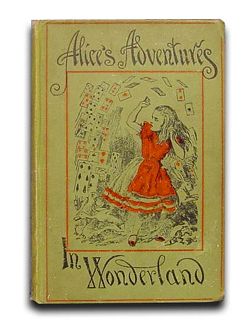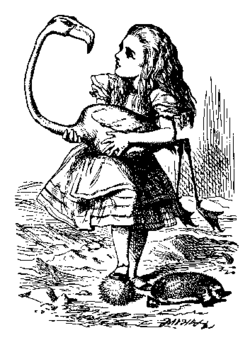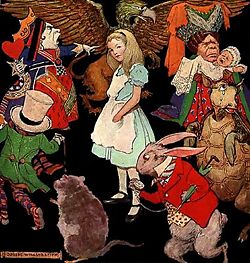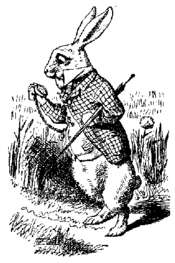Alice's Adventures in Wonderland
2008/9 Schools Wikipedia Selection. Related subjects: Children's Books
| Alice's Adventures in Wonderland | |
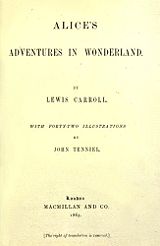 Title page of the original edition (1865) |
|
| Author | Charles "Lewis Carroll" Dodgson |
|---|---|
| Illustrator | John Tenniel |
| Country | England |
| Language | English |
| Genre(s) | Children's fiction |
| Publisher | Macmillan |
| Publication date | 1865 |
| Media type | |
| Followed by | Through the Looking-Glass |
Alice's Adventures in Wonderland (1865) is a surreal work of literary nonsense written by English author Charles Lutwidge Dodgson under the pseudonym Lewis Carroll, considered a classic example of the genre and of English literature in general. It tells the story of a girl named Alice who falls down a rabbit-hole into a fantastic realm populated by peculiar and anthropomorphic creatures.
The tale is filled with allusions to Dodgson's friends (and enemies), and to the lessons that British schoolchildren were expected to memorize. The tale plays with logic in ways that have made the story of lasting popularity with adults as well as children. It is considered to be one of the most characteristic examples of the genre of literary nonsense, and its narrative course and structure has been enormously influential, mainly in the fantasy genre (see Works influenced by Alice in Wonderland).
The book is commonly referred to by the abbreviated title Alice in Wonderland, an alternative title popularized by the numerous stage, film and television adaptations of the story produced over the years. Some printings of this title contain both Alice's Adventures in Wonderland and its sequel Through the Looking-Glass, and What Alice Found There.
History
Alice was first published on 4 July 1865, exactly three years after the Reverend Charles Lutwidge Dodgson and the Reverend Robinson Duckworth rowed in a boat up the River Thames with three little girls:
- Lorina Charlotte Liddell (aged 13) ("Prima" in the book's prefatory verse)
- Alice Pleasance Liddell (aged 10) ("Secunda" in the prefatory verse)
- Edith Mary Liddell (aged 8) ("Tertia" in the prefatory verse)
The journey had started at Folly Bridge near Oxford and ended five miles away in the village of Godstow. To while away time the Reverend Dodgson told the girls a story that, not so coincidentally, featured a bored little girl named Alice who goes looking for an adventure.
The girls loved it, and Alice Liddell asked Dodgson to write it down for her. After a lengthy delay - over two years - he eventually did so and on 26 November 1864 gave Alice the manuscript of Alice's Adventures Under Ground. Some, including Martin Gardner, speculate there was an earlier version that was destroyed later by Dodgson himself when he printed a more elaborate copy by hand (Gardner, 1965), but there is no known prima facie evidence to support this.
But before Alice received her copy, MS Dodgson was already preparing it for publication and expanding the 18,000-word original to 35,000 words, most notably adding the episodes about the Cheshire Cat and the Mad Tea-Party. In 1865, Dodgson's tale was published as Alice's Adventures in Wonderland by " Lewis Carroll" with illustrations by John Tenniel. The first print run of 2,000 was destroyed because Tenniel had objections over the print quality. (Only 23 copies are known to have survived; 18 are owned by major archives or libraries, such as the Harry Ransom Humanities Research Centre, while the other five are held in private hands.) A new edition, released in December of the same year but carrying an 1866 date, was quickly printed.
The entire print run sold out quickly. Alice was a publishing sensation, beloved by children and adults alike. Among its first avid readers were young Oscar Wilde and Queen Victoria. The book has never been out of print. Alice's Adventures in Wonderland has been translated into 125 languages, including Esperanto and Faroese. There have now been over a hundred editions of the book, as well as countless adaptations in other media, especially theatre and film.
Publishing highlights
- 1865: Alice has its first American printing.
- 1871: Dodgson meets another Alice during his time in London, Alice Raikes, and talks with her about her reflection in a mirror, leading to another book Through the Looking-Glass and What Alice Found There, which sells even better.
- 1886: Carroll publishes a facsimile of the earlier Alice's Adventures Under Ground manuscript.
- 1890: He publishes The Nursery "Alice", a special edition "to be read by Children aged from Nought to Five."
- 1908: Alice has its first translation into Japanese.
- 1960: American writer Martin Gardner publishes a special edition, The Annotated Alice, incorporating the text of both Alice's Adventures in Wonderland and Through the Looking-Glass. It has extensive annotations explaining the hidden allusions in the books, and includes full texts of the Victorian era poems parodied in them. Later editions expand on these annotations.
- 1961: The Folio Society publication with 42 illustrations by John Tenniel.
- 1964: Alicia in Terra Mirabili is published: the first Latin translation of the book.
- 1998: One of the few surviving copies of the 1865 first edition is sold at auction for US$1.5 million, becoming the most expensive children's book ever traded. This record was effaced when a Harry Potter book by J.K. Rowling, The Tales of Beedle the Bard, was sold at auction at US$3.9 million in 2007.
Synopsis
Chapter 1: Down the Rabbit Hole
Alice is sitting by her sister lazily and became a bit tired, and she sees a White Rabbit in a waistcoat carrying a watch. She follows it down a rabbit hole, and falls down a very long chamber full of strange things on shelves. After landing safely on the ground, she goes into a long hallway with a glass table with a gold key. Alice opens up a curtain and finds a small door, which the key fits in perfectly, and behind it is a beautiful garden, but she can't fit in. Alice then finds a small bottle labeled "DRINK ME," and drinks it. The drink causes her to shrink. Alice accidentally leaves the key on the table, and with her diminished stature can no longer reach it and becomes very scared. She then sees a cake that says "EAT ME," and proceeds to eat it.
Chapter 2: The Pool of Tears
The consumption of the cake makes Alice grow to be 9 feet tall. She cries, creating a pool of tears. The White Rabbit comes into the hallway, and is so frightened he drops his fan and kid-gloves. Alice then fans herself with his fan and kid-gloves, causing her to shrink again, but she stops before she goes out altogether. She swims through the pool of tears she had cried when she was larger, and finds a mouse who is awfully scared of cats. They wash up onto a bank, where they meet many birds and animals, who are also soaking wet.
Chapter 3: A Caucus Race and a Long Tale
A Dodo decides that the birds and animals should dry off with a Caucus Race, which has no rules except to run in a circle. After half an hour or so, the race ends and everyone wins, which means they all get prizes. Alice gives out her comfits as the prizes, and the Mouse tells Alice his long and sad tale of why he hates cats, which Alice misinterprets as "tail." The chapter ends with Alice alienating the participants of the race, resulting in her being left alone once again.
Chapter 4: The Rabbit Sends in a Little Bill
The White Rabbit mistakes Alice for his house maid, Mary Ann. He asks her to fetch a pair of gloves and a fan. Alice goes in to his house, and she finds a bottle. Though not labeled DRINK ME she drinks it anyway. The drink now makes her grow so big that she blocks the entrance and the White Rabbit is no longer able to get into the house. The White Rabbit asks a lizard named Bill to get her out. Bill climbs in through the chimney, but is kicked out by Alice's giant leg that is stuck there. The White Rabbit then decides out loud that house should be burned down, where Alice then responds fervently "If you do I'll set Dinah at you!", Dinah being a young kitten that Alice owns. Silence follows and then chatter about 'A barrowful will do, to begin with' followed by a shower of little pebbles being thrown through the window. The pebbles quickly turn into small cakes and Alice swallows one, suddenly causing her to shrink again to her earlier size. Back down to size Alice makes her way out of the house to find a small crowd of assorted animals, who in turn make a rush toward Alice when they see her. Quickly retreating into the nearby thick wood she finds herself confronted by an enormous puppy (note that Alice is merely a few inches tall at this time) and plays fetch with the puppy, tiring him into sleep. She rests for a moment herself, looking around and spotting a mushroom growing near her, she examines all angles of the mushroom and decides to have a peek at what might be on top of it. As she stands tiptoe and looks, her eyes meet with the ones of a blue Caterpillar, who is sitting arms folded quietly smoking a hookah.
Chapter 5: Advice from a Caterpillar
Alice asks how she can get bigger, but the Caterpillar asks her to recite "Old Father William" instead. After doing so (with a few errors), the Caterpillar tells her that one side of the mushroom will make her bigger and the other side will make her smaller. The Caterpillar disappears leaving Alice all alone. Alice first tries the right side, which makes her chin get stuck to her foot. Then she tries the left side, which makes her neck grow very long. A pigeon flies into her face, believing she is a serpent, but Alice tells her that she is a little girl. She then eats different sides of the mushroom and gets back to her usual height.
Chapter 6: Pig and Pepper
Now at her right size, Alice comes upon a house with a Frog-Footman and a Fish-Footman in front. The Fish-Footman has an invitation for the Duchess, which he delivers to the Frog-Footman. Alice observes this transaction and, after a perplexing conversation with the frog, goes into the house and meets The Duchess, The Cook, The Baby, and The Duchess's Cheshire-Cat. The Cook is throwing dishes and making a soup which has too much pepper, which causes Alice, the Duchess and the baby, but not the cook or the Cheshire-Cat, to sneeze. The Duchess tosses her baby up and down while reciting the poem "Speak roughly to your little boy." When the poem is over, The Duchess gives Alice the baby while she leaves to go play croquet with the Queen. To Alice's surprise, the baby later turns into a pig, so she lets it go off into the woods. The Cheshire-Cat then appears in a tree, telling her about the Mad Hatter and the March Hare. He then disappears, his grin remaining behind to float on its own in the air.
Chapter 7: A Mad Tea Party
Alice becomes a guest at a mad tea party, along with the Hatter, the March Hare, and the Dormouse. In the course of the party, Alice reveals that the date is May 4 (which happens to be the birthday of her presumed real-life counterpart, Alice Pleasance Liddell). The other characters give Alice many riddles and stories, until she becomes so insulted that she leaves, claiming that it was the stupidest tea party that she had ever been to. Alice comes upon a door in a tree, and enters it, and finds herself back in the long hallway. She opens the door, eats part of her mushroom, and shrinks so she can get into the beautiful garden.
Chapter 8: The Queen's Croquet Ground
Now in the beautiful garden, she comes upon 3 cards painting the roses on a rose tree red, for they accidentally planted a white-rose tree which the Queen of Hearts hates. A procession of more cards, kings and queens and even the White Rabbit comes into the garden. She meets the violent Queen of Hearts and the less violent King of Hearts. The Queen tells the executioner to chop off the three card gardeners' heads.
A game of croquet begins, with flamingos as the mallets and hedgehogs as the balls. The Queen condemns more people to death, and Alice once again meets the Cheshire Cat, who asks her how the queen is. The Queen of Hearts then tries to find out how they can chop off the Cheshire Cat's head, even though he is only a floating head. Alice asks her about the Duchess, so the Queen asks the executioner to get the Duchess out of prison.
Chapter 9: The Mock Turtle's story
The Duchess is brought to the croquet ground. She is now less angry and is always trying to find morals in things (she claims the pepper made her angry.) The Queen of Hearts then shows Alice the Gryphon, who takes her to the Mock Turtle. The Mock Turtle is very sad, even though he has no sorrow. He tries to tell his story about how he used to be a turtle, which The Gryphon interrupts so they can play a game.
Chapter 10: The Lobster Quadrille
The Mock Turtle and the Gryphon start dancing to the Lobster Quadrille, singing "Tis the Voice of the Lobster." The Mock Turtle then sings "Beautiful Soup" during which Alice and The Gryphon have to leave for a trial while The Mock Turtle continues singing.
Chapter 11: Who Stole the Tarts?
At the trial, the Knave of Hearts is accused of stealing the tarts. The jury box is made up of twelve animals, including Bill the Lizard, and the judge is the King of Hearts. The first witness is the Mad Hatter, who doesn't help the case at all. In some versions, the second witness is the Duchess's cook. The next and last witness though, is Alice.
Chapter 12: Alice's Evidence
Alice eats part of the mushroom, causing her to grow and accidentally knocks over the jury box. The Queen of Hearts is about to sentence them to death, but Alice calls them all just a pack of cards, causing them to swirl around her and turn into dead leaves. Alice's sister wakes her up, since it was all a dream. Alice tells her sister all about the strange dream she had just awoken from.
Characters in Alice's Adventures in Wonderland
- Alice
- The White Rabbit
- The Mouse
- The Dodo
- The Lory
- The Eaglet
- The Duck
- Bill the Lizard
- The Caterpillar
- The Duchess
- The Cheshire Cat
- The Hatter
- The March Hare
- The Dormouse
- The Queen of Hearts
- The Knave of Hearts
- The King of Hearts
- The Gryphon
- The Mock Turtle
Misconception of characters
Although Tweedledee, Tweedledum, Humpty Dumpty, and the Jabberwock are often thought to be characters in Alice's Adventures in Wonderland, they actually only appear later in Through the Looking-Glass. They are, however, often included in film versions, which are usually simply called "Alice in Wonderland," often causing the confusion.
Character allusions
The members of the boating party that first heard Carroll's tale all show up in Chapter 3 ("A Caucus-Race and a Long Tale") in one form or another. There is, of course, Alice herself, while Carroll, or Charles Dodgson, is caricatured as the Dodo. Carroll is known as the Dodo because Dodgson stuttered when he spoke, thus if he spoke his last name it would be Do-Do-Dodgson. The Duck refers to Rev. Robinson Duckworth, the Lory to Lorina Liddell, and the Eaglet to Edith Liddell.
Bill the Lizard may be a play on the name of Benjamin Disraeli. One of Tenniel's illustrations in Through the Looking-Glass depicts a caricature of Disraeli, wearing a paper hat, as a passenger on a train. The illustrations of the Lion and the Unicorn also bear a striking resemblance to Tenniel's Punch illustrations of Gladstone and Disraeli.
The Hatter is most likely a reference to Theophilus Carter, a furniture dealer known in Oxford for his unorthodox inventions. Tenniel apparently drew the Hatter to resemble Carter, on a suggestion of Carroll's.
The Dormouse tells a story about three little sisters named Elsie, Lacie, and Tillie. These are the Liddell sisters: Elsie is L.C. (Lorina Charlotte), Tillie is Edith (her family nickname is Matilda), and Lacie is an anagram of Alice.
The Mock Turtle speaks of a Drawling-master, "an old conger eel", that used to come once a week to teach "Drawling, Stretching, and Fainting in Coils". This is a reference to the art critic John Ruskin, who came once a week to the Liddell house to teach the children drawing, sketching, and painting in oils. (The children did, in fact, learn well; Alice Liddell, for one, produced a number of skilled watercolours.)
The Mock Turtle also sings "Turtle Soup". This is a parody of a song called "Star of the Evening, Beautiful Star", which was performed as a trio by Lorina, Alice and Edith Liddell for Lewis Carroll in the Liddell home during the same summer in which he first told the story of Alice's Adventures Under Ground (source: the diary of Lewis Carroll, August 1, 1862 entry).
Contents
Poems and songs
- "All in the golden afternoon..." —the prefatory verse, an original poem by Carroll that recalls the rowing expedition on which he first told the story of Alice's adventures underground
- " How Doth the Little Crocodile" — a parody of Isaac Watts' nursery rhyme, " Against Idleness And Mischief"
- " The Mouse's Tale" —an example of concrete poetry
- " You Are Old, Father William" — a parody of Robert Southey's " The Old Man's Comforts and How He Gained Them"
- The Duchess' lullaby, "Speak roughly to your little boy..." — a parody of David Bates' " Speak Gently"
- "Twinkle, twinkle little bat..." — a parody of " Twinkle twinkle little star"
- The Lobster Quadrille — a parody of Mary Botham Howitt's "The Spider and the Fly"
- " 'Tis the Voice of the Lobster" — a parody of " The Sluggard"
- Turtle Soup — a parody of James M. Sayles' "Star of the Evening, Beautiful Star"
- "The Queen of Hearts..." — an actual nursery rhyme
- "They told me you had been to her..." — the White Rabbit's evidence
Tenniel's illustrations
John Tenniel's illustrations of Alice do not portray the real Alice Liddell, who had dark hair and a short fringe. Carroll sent Tenniel a photograph of Mary Hilton Babcock, another child-friend, but whether Tenniel actually used Babcock as his model is open to dispute.
Famous lines and expressions
The term " Wonderland", from the title, has entered the language and refers to a marvellous imaginary place, or else a real-world place that one perceives to have dream like qualities. It challenges and takes on real-life matters. It, like much of the Alice work, is widely referred to in popular culture.
"Down the Rabbit-Hole", the Chapter 1 title, has become a popular term for going on an adventure into the unknown. In computer gaming, a "rabbit hole" may refer to the initiating element that drives the player to enter the game. In drug culture, "going down the rabbit hole" is a metaphor for taking drugs.
In Chapter 6, the Cheshire Cat's disappearance prompts Alice to say one of her most memorable lines: "...a grin without a cat! It's the most curious thing I ever saw in all my life!"
In Chapter 7, the Hatter gives his famous riddle without an answer: "Why is a raven like a writing desk?" Although Carroll intended the riddle to have no solution, in a new preface to the 1896 edition of Alice, he proposes several answers: "Because it can produce a few notes, though… they are very flat; and it is nevar put with the wrong end in front!" (Note the spelling of "never" as "nevar"—turning it into "raven" when inverted. This spelling, however, was "corrected" in later editions to "never" and Carroll's pun was lost). Puzzle expert Sam Loyd offered the following solutions:
- Because the notes for which they are noted are not noted for being musical notes
- Poe wrote on both
- They both have inky quills
- Bills and tales are among their characteristics
- Because they both stand on their legs, conceal their steels (steals), and ought to be made to shut up
Many other answers are listed in The Annotated Alice. In Frank Beddor's novel Seeing Redd, the main antagonist, Queen Redd (a megalomaniac parody of the Queen of Hearts) meets Lewis Carroll and declares that the answer to the riddle is "Because I say so." Carroll is too terrified to contradict her.
Arguably the most famous quote is used when the Queen of Hearts screams "Off with her head!" at Alice (and everyone else she feels slightly annoyed with). Possibly Carroll here was echoing a scene in Shakespeare's Richard III (III, iv, 76) where Richard demands the execution of Lord Hastings, crying "Off with his head!"
When Alice is growing taller after eating the cake labeled "Eat me" she says, "curiouser and curiouser", a famous line that is still used today to describe an event with extraordinary wonder.
Symbolism in the text
Cinematic adaptations
- Alice in Wonderland (1903 film) - the first Alice movie by Cecil M. Hepworth. Parts of the movie are lost but what remains is available as a bonus feature on the 1966 BBC DVD;
- Alice in Wonderland (1933 film) - motion picture
- Alice in Wonderland (1946 film) directed by George More O'Ferrall, starring Vivien Pickles for BBC television
- Alice in Wonderland (1951 Bunin film)PD - motion picture produced by Lou Bunin, blending live actors with stop-motion animated puppets, nicknamed "the lost Alice." It was suppressed by Disney to avoid competition with their release the same year.
- Alice in Wonderland (1951 Disney film) animated feature. It popularized the iconic image of Alice in America as a pretty blonde girl in a white pinafore and a blue dress. The character designs owe much to the original iconic Tenniel illustrations. The Disney feature combines story elements from both Alice books. It is notable for its distinctly psychedelic visual feel.
- The Adventures of Alice (1960 film) produced by Charles Le Faux, starring Gillian Ferguson for BBC television
- Alice in Wonderland (1966 film) - directed by Jonathan Miller for BBC television
- Alice of Wonderland in Paris - 1966 animated movie
- Alice in Wonderland (or What’s a Nice Kid Like You Doing in a Place Like This?) - Animated 1966 TV-movie by Hanna-Barbera.
- Alice's Adventures in Wonderland (1972 film) - motion picture
- Alice in Wonderland (1976 film) - referred to as a "pornographic musical fantasy"
- Alice in Wonderland (1981 film) (Russian: "Алиса в Стране Чудес"--transliteration: "Alisa in the Country of Miracles") - Soviet animated motion picture by Efim Pruzhanskiy
- Lewis Carroll's Alice in Wonderland (1982 film) produced by John Clark Donahue, directed by John Driver, starring Annie Enneking, filmed stage play by Children's Theatre Company from USA
- Fushigi no Kuni no Alice - 1983 animated series from Japan.
- Alice in Wonderland (1985 film) - motion picture
- Alice in Wonderland (1985 Anglia TV series) produced/directed by Harry Aldous, starring Giselle Andrews, puppetry/live action, five 20 minute episodes
- Alice in Wonderland (1986 BBC TV series) produced by Terrance Dicks, written/directed by Barry Letts, starring Kate Dorning, four 30 minute episodes
- The Care Bears Adventure In Wonderland (1987) - Animated movie
- Alice in Wonderland (1988 film)PD - animated motion picture made in Australia
- Alice (1988 film) - animated motion picture by Jan Švankmajer
- Alice in Wonderland (1999 film) - made-for-television movie
- Alice's Misadventures in Wonderland (2004 film)
- PD: public domain
Live performance
Lewis Carroll's most famous work has also inspired numerous live performances, including plays, operas, ballets, and traditional English pantomimes. These works range from adaptations which are fairly faithful to the original book to those which use the story as a basis for new works. A good example of the latter is The Eighth Square, a murder mystery set in Wonderland. Written by Matthew Fleming and Music & Lyrics by Ben J Macpherson. This goth-toned rock musical premiered in 2006 at the New Theatre Royal in Portsmouth, England.
With the immediate popularity of the book, it didn't take long for live performances to begin. One early example is Alice in Wonderland, a musical play by H. Saville Clark (book) and Walter Slaughter (music), which played in 1886 at the Prince of Wales Theatre in London.
Over the years, many notable people in the performing arts have been involved in Alice productions. One of the most well-known American productions was Joseph Papp's 1980 staging of Alice in Concert at the Public Theatre in New York City. Elizabeth Swados wrote the book, lyrics, and music. Based on both Alice's Adventures in Wonderland and Through the Looking-Glass, Papp and Swados had previously produced a version of it at the New York Shakespeare Festival. Meryl Streep played Alice, the White Queen, and Humpty Dumpty. The cast also included Debbie Allen, Michael Jeter, and Mark Linn-Baker. Performed on a bare stage with the actors in modern dress, the play is a loose adaptation, with song styles ranging the globe.
A free theatre script of Alice's Adventures in Wonderland is available from FunAntics Theatre Scripts here. It includes the original poems that schoolchildren were expected to recite such as "You are Old Father William" and "The Voice of the Sluggard" which Lewis Carroll satirized.
Similarly, the 1992 operatic production Alice used both Alice books as its inspiration. However, it also employs scenes with Charles Dodgson, a young Alice Liddell, and an adult Alice Liddell, to frame the story. Paul Schmidt wrote the play, with Tom Waits and Kathleen Brennan writing the music. Although the original production in Hamburg, Germany, received only a small audience, Tom Waits released the songs as the album Alice in 2002, to much acclaim.
In addition to professional performances, school productions abound. Both high schools and colleges have staged numerous versions of Alice-inspired performances. The imaginative story and large number of characters are well-suited to such productions.
A large-scale operatic adaptation of the story by the Korean composer Unsuk Chin to an English language libretto by David Henry Hwang received its world premiere at the Bavarian State Opera on June 30, 2007.
Criticism
The book was generally received in a positive light, but has also caught a large amount of derision for its strange and unpredictable tone. One of the best-known critics is fantasy writer Terry Pratchett, who has openly stated that he dislikes the book.
In 1931, the book was banned in Hunan, China because "animals should not use human language" and it "put animals and human beings on the same level."
Works influenced
Alice and the rest of Wonderland continue to inspire or influence many other works of art to this day, sometimes indirectly via the Disney movie, for example. The character of the plucky, yet proper, Alice has proven immensely popular and inspired similar heroines in literature and pop culture, many also named Alice in homage.
Other tributes to the story
The city of Warrington in Cheshire, the nearest city to the village of Daresbury where the Reverend Dodgson lived and worked, has several statues of figures from the story. The church in Daresbury, likewise, memorialises the story in several stained glass windows.

